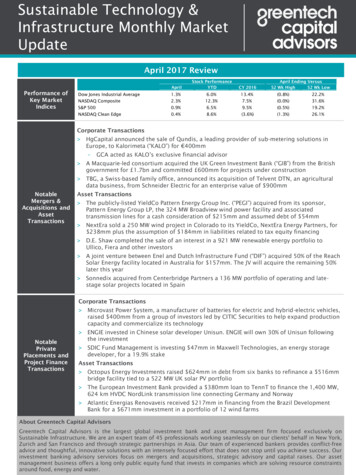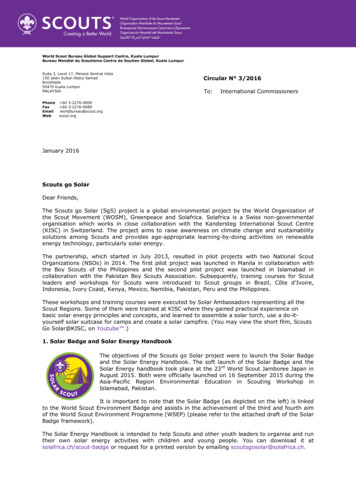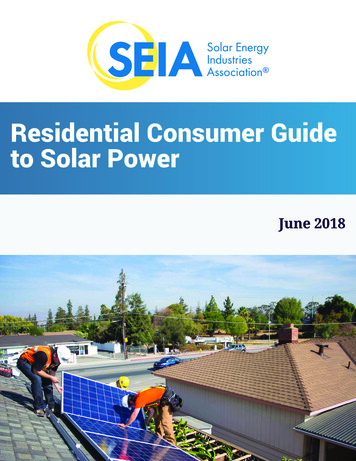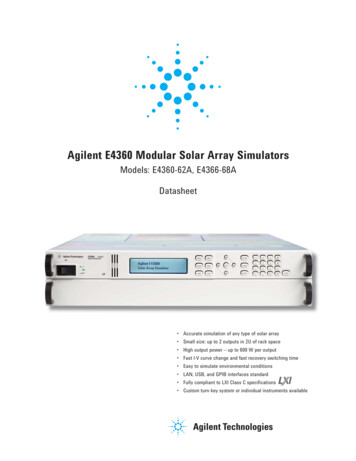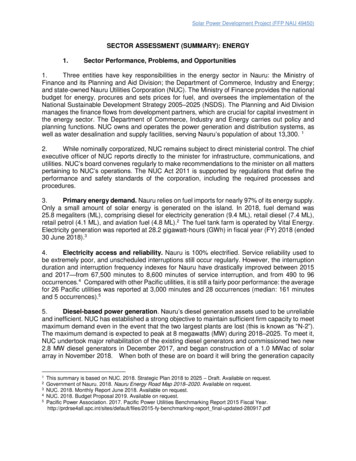
Transcription
Solar Power Development Project (FFP NAU 49450)SECTOR ASSESSMENT (SUMMARY): ENERGY1.Sector Performance, Problems, and Opportunities1.Three entities have key responsibilities in the energy sector in Nauru: the Ministry ofFinance and its Planning and Aid Division; the Department of Commerce, Industry and Energy;and state-owned Nauru Utilities Corporation (NUC). The Ministry of Finance provides the nationalbudget for energy, procures and sets prices for fuel, and oversees the implementation of theNational Sustainable Development Strategy 2005–2025 (NSDS). The Planning and Aid Divisionmanages the finance flows from development partners, which are crucial for capital investment inthe energy sector. The Department of Commerce, Industry and Energy carries out policy andplanning functions. NUC owns and operates the power generation and distribution systems, aswell as water desalination and supply facilities, serving Nauru’s population of about 13,300. 12.While nominally corporatized, NUC remains subject to direct ministerial control. The chiefexecutive officer of NUC reports directly to the minister for infrastructure, communications, andutilities. NUC’s board convenes regularly to make recommendations to the minister on all matterspertaining to NUC’s operations. The NUC Act 2011 is supported by regulations that define theperformance and safety standards of the corporation, including the required processes andprocedures.3.Primary energy demand. Nauru relies on fuel imports for nearly 97% of its energy supply.Only a small amount of solar energy is generated on the island. In 2018, fuel demand was25.8 megaliters (ML), comprising diesel for electricity generation (9.4 ML), retail diesel (7.4 ML),retail petrol (4.1 ML), and aviation fuel (4.8 ML).2 The fuel tank farm is operated by Vital Energy.Electricity generation was reported at 28.2 gigawatt-hours (GWh) in fiscal year (FY) 2018 (ended30 June 2018).34.Electricity access and reliability. Nauru is 100% electrified. Service reliability used tobe extremely poor, and unscheduled interruptions still occur regularly. However, the interruptionduration and interruption frequency indexes for Nauru have drastically improved between 2015and 2017—from 67,500 minutes to 8,600 minutes of service interruption, and from 490 to 96occurrences.4 Compared with other Pacific utilities, it is still a fairly poor performance: the averagefor 26 Pacific utilities was reported at 3,000 minutes and 28 occurrences (median: 161 minutesand 5 occurrences).55.Diesel-based power generation. Nauru’s diesel generation assets used to be unreliableand inefficient. NUC has established a strong objective to maintain sufficient firm capacity to meetmaximum demand even in the event that the two largest plants are lost (this is known as “N-2”).The maximum demand is expected to peak at 8 megawatts (MW) during 2018–2025. To meet it,NUC undertook major rehabilitation of the existing diesel generators and commissioned two new2.8 MW diesel generators in December 2017, and began construction of a 1.0 MWac of solararray in November 2018. When both of these are on board it will bring the generation capacity12345This summary is based on NUC. 2018. Strategic Plan 2018 to 2025 – Draft. Available on request.Government of Nauru. 2018. Nauru Energy Road Map 2018–2020. Available on request.NUC. 2018. Monthly Report June 2018. Available on request.NUC. 2018. Budget Proposal 2019. Available on request.Pacific Power Association. 2017. Pacific Power Utilities Benchmarking Report 2015 Fiscal /2015-fy-benchmarking-report final-updated-280917.pdf
2to 9 MW and aiming at 18.8 MW total operational capacity.66.Renewable energy power generation. The Government of Nauru has set the objectiveof 50% renewable energy in the grid by 2025. Currently, 807 kilowatt of photovoltaic units areinstalled on the island, with construction ongoing to install an additional 1.0 MWac as noted above.Nauru also has the potential for an additional 2 MW of rooftop solar availability.7 Although Nauruhas set ambitious targets for renewable generation, it still relies on thermal generation (i.e., diesel)for base load, system stability, and reliability in the foreseeable future.7.Power distribution. Nauru has a ring main distribution system with 11-kilovolt, 3.3-kilovolt,and 415-volt sections. The overhead distribution network is aging, and large parts are in need ofoverhaul or complete replacement. NUC has begun to replace the steel poles with wooden onesand to replace faulty line fuses to reduce the extended outages. NUC also has plans to replaceand upgrade distribution equipment to cater for future load growth and future renewable energygeneration that is connected to the grid.8.Electricity demand. The total yearly electricity demand in 2017–2018 was about 28 GWh,peaking at 4.1 MW.8 NUC recorded domestic demand at 48%, commercial demand at 34%,industrial demand at 2%, and government demand at 14%, with non-revenue activitiesrepresenting 2% before losses. Losses represent about 23% of electricity supply. It is planned toconnect the Nauru Regional Processing Centre, an Australian offshore detention facility, andadditional activities of Republic of Nauru Phosphate Corporation to the grid in the near future,bringing total electricity demand on the island to 43 GWh per year. However, it is still uncertain towhat extent the detention facility and the phosphate activities will actually come on line and requireelectricity from the grid.99.Electricity tariffs. Historically, electricity was provided for free. When tariffs wereintroduced, they were artificially low and bill collection was not enforced. This resulted in very highaverage household electricity use by Pacific standards, estimated at about 400 kilowatt-hour(kWh) per month. To gradually get the population to pay for electricity, prepaid meters wereinstalled in 2009 for most domestic and some commercial customers. The current tariffs in Nauruare: A 0.25 per kWh for prepaid residential use up to the first 200 kWh per month (known as a“lifeline” rate); A 0.50 per kWh for prepaid residential use above 150 kWh and postpaid residentialuse; and A 0.75 per kWh for commercial, industrial, and government customers. This placesNauru’s residential tariffs below the average residential tariff charged by 22 Pacific utilities(A 0.58) but above their average of A 0.62 for commercial customers. Full cost-recovery levelsare estimated between A 0.45 and A 0.49 per kWh).1010.Utility’s financial performance. In FY2017, NUC made significant progress in achievingits goal of becoming financially sustainable by 2020. It improved profitability to A 2.7 million,compared with a profit of A 0.2 million in FY2015 and a loss of A 1.5 million in FY2016. As agovernment-subsidized entity, NUC was allocated A 5.9 million in FY2017, A 0.5 million lessthan the previous year.This summary is based on NUC. 2018. Strategic Plan 2018 to 2025 – Draft.This summary is based on ADB. 2018. Nauru Solar Power Expansion Plan. Consultant report.8 NUC. 2018. July 2018 Monthly Report. Nauru.9 This summary is based on ADB. 2018. Nauru Solar Power Expansion Plan. Consultant report.10The Pacific Power Association. 2018. Performance Benchmarking Report for Pacific Power Utilities, /2015-fy-benchmarking-report final-updated-280917.pdf67
311.Weaknesses. Some of the weaknesses of the energy sector are:11(i)Complications and uncertainty arise from sector governance issues, such asthe lack of clarity about the role and responsibilities of NUC’s board of directors,the role of the line ministry, and the role of other government institutions suchas the Department of Commerce, Industry and Environment.(ii)Insufficient attention is paid to customer metering, billing, and collection toensure that all customers connected to the grid deliver their share to the utility.(iii)Electricity payments from government agencies are often delayed considerably,which hurts NUC’s cash flow.(iv)NUC lacks an asset registry and customer inventory to ensure that it has fullcontrol over its operations and the power system.(v)Lack of organizational clarity results in functional overlaps and could lead toperformance gaps.(vi)NUC’s succession planning is poor or missing, which may lead to a lack ofqualified personnel ready to assume leadership roles in the event of seniormanagement turnover.(vii)Lack of documented policies and practices at NUC, such as a financial policy.12.Opportunities. As NUC’s program to upgrade its diesel generation and distribution assetsis well under way, and with plans under the ADB grant to bring renewable energy to about 50%of the grid’s electricity mix, most opportunities lie in demand-side management—such as reducingnon-technical losses by improving metering, carrying out regular analysis of data obtained frommetering, and enforcing penalties against customers found to be stealing power by tamperingwith the meters. The present condition of the assets (e.g., network, power plant) is fair and couldbe improved with time-bound measures focused on distribution, customer metering, billing, andcollection.2.Government’s Sector Strategy13.National Sustainable Development Strategy 2005–2025. The 20-year NSDS outlinesNauru’s vision of “providing reliable, affordable, secure, and sustainable energy supply to meetthe socioeconomic development needs of Nauru.”12 It defines a plan to implement a nationalenergy policy framework through (i) cost-effective, secure, and sustainable procurement andsupply of fuel; (ii) reliable and efficient energy supply and distribution; (iii) management of demandfocusing on consumption efficiency and conservation; and (iv) increased use of renewable energyand other alternative forms of energy. It also sets the goal of meeting 50% of Nauru’s energyneeds through renewable energy by 2020. The NSDS was reviewed in 2018, and an updatedversion is currently undergoing government approval. The updated version is expected toinclude performance targets and indicators.14.National Energy Policy Framework 2009. The National Energy Policy Framework(NEPF) aims to guide the development of the energy sector in Nauru, including in the long term.13It identifies seven strategic policy areas as critical to achieving its overall vision: power, petroleum,renewable energy, consumers, finance, institutional capacity, and energy conservation andefficiency. An updated NEPF was issued in early 2019.11This summary is based on ADB 2019. Nauru Pre-Assignment Report. Consultant report.Nauru. 2005. National Sustainable Development Strategy 2005–2025, 2009 inked-documents/cobp-nau-2015-2017-sd-02.pdf13 Nauru. 2009. National Energy Policy Framework. http://prdrse4all.spc.int/system/files/nauru policy- final.pdf12
415.Nauru Energy Road Map 2014–2020. The Nauru Energy Road Map (NERM) is built uponthe development agendas outlined in the NSDS and NEPF.14 It has seven expected outcomes:(i) reliable, affordable, and safe power supply and services; (ii) a reliable and safe supply of fossilfuels; (iii) universal access to reliable and affordable energy services; (iv) efficient supply and useof energy; (iv) a significant contribution from renewable energy to electricity supply; (v) financialsustainability of the energy sector; and (vi) efficient, robust, and well-resourced institutions forenergy planning and implementation. The NERM targets by 2020 include (i) all-year, around-theclock grid electricity supply with minimal interruptions; (ii) 50% of grid electricity supplied byrenewable energy sources; and (iii) 30% improvement in energy efficiency in the residential,commercial, and government sectors. The NERM details six action plans, 19 strategies, and110 activities. It also includes a monitoring, evaluation, and reporting framework.16.The NERM’s action plans, strategies, and activities are consistent with the visions, aims,and strategies of the NSDS and NEPF. The strategies, full of adjectives such as "appropriate","affordable", "reliable", and "safe", are not defined in detail. As of November 2017, the power andpetroleum strategies were completely or partly implemented, the renewable energy and demandstrategies were partly implemented, and the transport and institutional strategies were globallynot implemented.153.ADB Sector Experience and Assistance Program17.Previous ADB technical and consulting assistance to Nauru’s energy sector supported the(i) development of legislation governing NUC in 2011, (ii) preparation of an inventory of assets,(iii) NUC’s formulation of a corporate strategy, and (iv) introduction of a performance managementsystem for senior NUC management.16 ADB also provided technical assistance to support NUCin the following activities: (i) developing and implementing an asset management andmaintenance plan, (ii) improving accounting systems through integration of the asset registry andthe financial management information system, (iii) implementing performance managementsystems for lower-level staff, and (iv) reviewing the organization’s corporate governance. 17Unclear compensation policies and worker classifications resulted in inefficient allocation ofcompensation at the NUC. While an asset inventory was introduced under ADB technicalassistance (footnote 17), additional improvements are required to the accounting system, inparticular the integration of the fixed asset register and the financial management informationsystem’s fixed asset management module, which was acquired for NUC. There is also a lack ofmanagement autonomy, despite NUC’s corporatization. And although NUC streamlined itsgovernance structure, it is still subject to ministerial oversight and requires cabinet approval toborrow, acquire, and dispose of property, rather than being accountable to an independent boardof directors. NUC depends on imported diesel fuel for almost all power generation. Its tariffs arethe lowest in the Pacific and do not cover diesel fuel costs. The utility therefore depends on a fuelsubsidy from the government.18.14Furthermore, ADB approved a 4.7 million grant for and administration of the ElectricityGovernment of Nauru. 2014. National Energy Road Map ites/default/files/second draft nauru energy road map v6 0.pdf15 This summary is based on ITP. 2018. Review of the NERM t/files/nerm review 150118.pdf16 ADB. 2011. Technical Assistance to Nauru for Regulatory and Governance Reform for Improved Water andElectricity Supply. Manila.17 ADB. 2014. Technical Assistance for Institutional Strengthening of the Nauru Utilities Corporation. Manila.
5Supply Security and Sustainability Project (cofinanced by the European Union) in 2014. This grantaimed to increase the reliability, lower the costs, and improve the sustainability of powergeneration in Nauru and allowed the installation of two new diesel generators (2.6–3.0 MW)commissioned in December 2017 and repairs to the powerhouse roof structure, which werecompleted in June 2017.18Problem Tree for Energy SectorNUC Nauru Utilities CorporationGoN Government of Nauru18ADB. 2014. Nauru Electricity Supply Security and Sustainability. Manila.
(NEPF) aims to guide the development of the energy sector in Nauru, including in the long term.13 It identifies seven strategic policy areas as critical to achieving its overall vision: power, petroleum, renewable energy, consumers, finance, institutional capacity, and energy conservation and efficiency.


